Roller Derby Revolution
Roller derby has been called a “feminist punk fever dream” but it’s also gaining ground as an international sport, with two of Vermont’s top skaters headed to the International Championships in Montreal this month.
“Next up to jam for Gryffindor is TrasHer.” A petite woman, face painted fiercely, wearing a black dance skirt and wide fishnet tights over powerful thighs, rolls up to toe the jam line. Her helmet features a red sleeve with a lone gold star, the mark of a jammer. Her leather roller skates have four bright green wheels.
The whistle blows and TrasHer, a 37-year-old mom and daycare provider better known as Trisha DiFonzo, dives into the pack of women ahead of her, shoulder down. Chaos consumes her—bodies thud, wheels squeak against the floor and one skater is spit clear off the track mercilessly landing on her butt with a thud before popping up to re-enter the fray.
Seconds later, TrasHer emerges on the other side, shot like a ball from a slingshot. Her legs cross and uncross gracefully as she hurls ahead of the pack, around the track, hips tucked low. When she catches the rest of the pack to lap them from behind, she spins elegantly, pumping both hands to her hips as she cocks a hip and faces the stands. There is the shrill of a whistle and then, the crowd roars.
This is a home bout at the Champlain Valley Expo in Essex Junction for Green Mountain Roller Derby, Vermont’s oldest women’s flat track roller derby league. Founded in 2007, it’s one of six leagues across the state, from Bennington to St. Johnsbury.

Though its current membership is small (about 26 in a sport where a full team roster is 15), GMRD has trained skaters who have gone on to compete at the international level, including Danielle Baker of Plattsburgh, N.Y. who skates by the name “Mayday Va*j*j*” for ninth-seeded New Skids on the Block, Montreal’s elite travel team.
This November 15-18, she and another skater with Vermont roots, Aylin Woodward, who skates for the Gotham Girls Roller Derby under the name, Yeti or Not, Here I Come, will compete at the 2019 International Women’s Flat Track Derby Association World Championships in Montreal, an event that will showcase the top 30 teams in the sport from four countries, including Argentina and Australia.
Woodward, a former Dartmouth alpine ski racer and ballet dancer, got her start skating with Vermont’s top-ranked league Twin State Derby, in the Upper Valley just four years ago.
Though fierce competition has been at the core of roller derby since the early aughts, its image is shifting.
At the top, Woodward says, “We are certainly seeing less fishnets, less theatrics. But that spirit’s not gone from the sport—it’s just that we’re seeing a different interpretation of it.”
Riotous Origins
“When we first started,” says Carrie Speranza, an 11-year veteran of Burlington-based Green Mountain Roller Derby who skates by Bust E. Breaker, “it was more like this underground punk thing. We wore a lot of fishnets and tiny skirts. For me, it felt like the makeup was taking away from people’s ability to see us as really skilled, highly trained athletes.”
Though roller derby has been around since the 1930s, today’s most popular version of the sport, women’s flat track roller derby, was born in 2001 over drinks in a bar in Austin, Texas. A group of friends formed the sport’s first player-owned league, the Texas Rollergirls, with the goal of creating a sport for women, by women.
Like any good grassroots movement, there are a lot of competing stories about its origins, but one thread remains constant: “[In the early days] it was: learn how not to fall down on roller skates, get a cool outfit, and hit somebody,” Suzy Hotrod, the longest-skating member of Division I Gotham Girls Roller Derby told Racked in 2017.
Uniforms were handsewn, players adopted names like Bettie Rage and Cat Tastrophe and fishnet stockings were ubiquitous. Flat track roller derby’s founders imbued their new sport with the politics and aesthetic of the Riot Grrrl movement. And though some of the rules were taken from a prior theatrical version of derby popularized in the 1960s and 1970s, where alternating teams of men and women faced off in full-contact team races on a banked track, in its reincarnation, roller derby gained both legitimacy as a sport and a certain edginess.
As the Women’s Flat Track Derby Association’s website reads today, “Skaters are ‘normal’ during the day…Roller Derby is our escape from day-to-day life and our opportunity to embrace a tougher, edgier side of ourselves.” According to reporting by The New York Times, modern derby names borrowed from Austin’s drag culture and punk scenes at the time.
In short, derby was reborn as third-wave feminism, embodied as a sport with emboldened theatrics that belied serious athleticism.
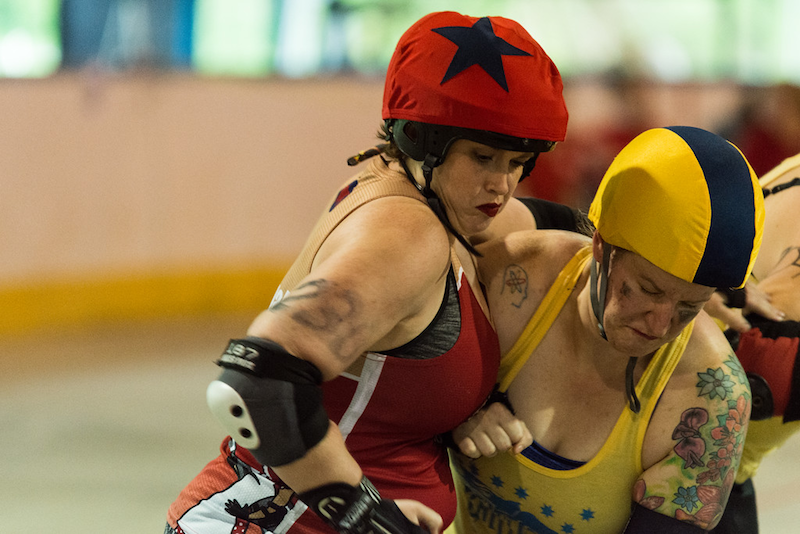
Early leagues built their own tracks in warehouses, old fairgrounds and gyms, self-funded tournaments and travel and constantly amended the rules. Gear was cheap or handmade, the athleticism required was raw, and the leagues were self-governed. What started as three leagues in Austin spread like wildfire across America.
Nearly 20 years later, flat track roller derby’s governing body, the Women’s Flat Track Derby Association (WFTDA), has nearly 500 member teams in 25 countries worldwide, with two located in Vermont (four more local teams are purely recreational or all-gender).
Today, the sport looks a little different from what it was in 2001. Most top players favor uniforms that channel volleyball more than punk rock and no longer compete in fishnets. Some skate under their real names and though the sport has stayed true to its player-run grassroots, the best athletes in the world train or skate as hard as professionals in other sports.
Giving (and Taking) a Good Hit
“When I put quad skates on, I feel like there’s a part of me that’s taking flight—there’s a freedom in moving as fast as you can on four wheels,” says Jenna Nunziata, 35, who skates by Schemestress for Twin State Derby’s A Team, the Upper Valley Vixens. She describes herself as “one of those kids who hung out at the roller rink.” Growing up in the 1990s, she played roller hockey and even did some jamming—hiphop dancing on roller skates—before diving into derby in the mid-2000s. Today, she’s one of the league’s star players, and formerly skated with Portland, Ore.’s Rose City Rollers, the league whose A team is currently seeded number one heading into the International Championships.
Women’s Flat Track Roller Derby is played in 60-minute bouts, a term borrowed from boxing. Two teams face off with five skaters each on a 108-meter oval track at a time. Bouts consist of jams, two-minute frenzied pushes for points in which each team’s jammer—the only player on the track who can score points—faces off against the other’s in a race to lap the pack of other skaters as they all skate counter-clockwise around the track.
At the start of a jam, two jammers toe the jam line, a horizontal line across the track set behind the eight blockers. After one sharp whistle, play begins, and the blockers try to clear the way to help their jammer through while blocking the other team’s jammer from getting the lead.
“The way teams move on the track and even some of the play formations are a lot like football,” says veteran Vermont skater and GMRD coach Trena Isley of Burlington, who goes by the skater name Strawburied Jam. “Except both teams are playing offense and defense at the same time and the jammer is the ball.”
Once one jammer breaks ahead of the pack, a ref declares them the lead jammer with two short shrill whistles, at which point they gain the power to stop play by tapping their hands to their hips. Points are scored when a lead jammer laps the other team’s players, skating fast circles around the track as the pack moves.
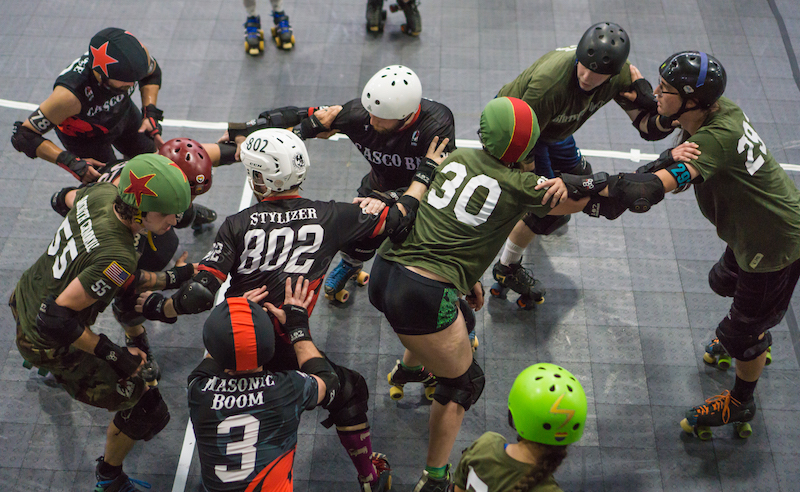
At every level of play, flat track roller derby is raucous. There are the screams of toe stops on wood, bodies hurling, hips being thrown and powerful bodies of all shapes and sizes tucking low as they fly, wheels a colorful blur, around a track. It is fierce and unapologetic, a full-contact sport that’s like a fusion of basketball, football and rugby on roller skates—with no ball and a lot of attitude.
Unlike running or even basketball, derby is a sport that rewards many different body types. It’s hard to typecast across positions. Some jammers are tiny and lithe, while some are powerful and tall. Blockers go the same way.
Off skates, skaters at GMRD, Twin State and Montpelier-based Vermont Roller Derby are doctors, bartenders, grief counselors, librarians and full-time parents. Some use they/them pronouns rather than she/her, and many skaters identify as LGBTQIA.
“This is not just a women’s sport,” says Woodward. “It’s a sport for anyone who identifies as a woman or gender non-binary.”
In Vermont and elsewhere, the best skaters leap, hop and skate backwards at full speed—and can keep their momentum doing so while taking a hard hit. Watching a roller derby bout can feel like watching full-contact ballet, where bruises and the occasional broken nose are worn as hard-earned battle scars.
“Whatever you’re dealing with off the track, there’s just nothing like hitting your best friend as hard as you can and having her be psyched about it to make you feel better,” says Isley.
Inspiring the Next Generation
“Roller derby gave me the feeling that I am a strong individual,” says GMRD vice president DiFonzo, (TrasHer), 37. The busy mom to three and daycare owner skates daily on the Burlington bike path and trains for derby by doing Cross-Fit several times a week. “It’s the contact that gets me to practice. I want to feel strong and feel other people being strong with me.”
Contact between skaters is a near constant in derby, whether it’s teammates bracing against each other at the start of a jam, small hip checks or big, powerful moves like the C-block, where a skater skates hard, parallel to their target, and suddenly curves their skates toward them to hit them squarely in the chest with their shoulder.
“When you take a hit that surprises you, especially for women skaters, I think it’s natural to get mad at first,” said DiFonzo. “Now when I take a good hit, I want to buy that player a beer at the bar after the bout and be like, ‘That was a great hit!’ Where else do we as women and nonbinary athletes get to do that?”
For DiFonzo, camp is also part of the fun. “Part of the appeal from the beginning for me was the alter ego, that you could have this split between real life and derby,” says DiFonzo, who often paints her face before bouts and skates in fishnets. “But when I do, I’m showing my strength. Being sexy doesn’t have to be in conflict with that.”
Carrie Speranza has been coaching the Minor Catastrophes, Green Mountain Roller Derby’s junior team, for the last six years. Open to girls 6 through 17, the team often has between 15 and 25 skaters in the program at a time.
“It’s an opportunity for girls to be powerful and use their bodies in a way that they wouldn’t get to normally,” says Speranza. “As girls get older, they’re still taught to be a little softer and kinder. Being aggressive as a woman is still often seen as a bad thing.” As a coach, she pairs older players with younger players as mentors. Speranza says, “I’ve seen these girls grow into leaders on the track, and take that confidence to their schools, to other sports. It’s pretty amazing.”
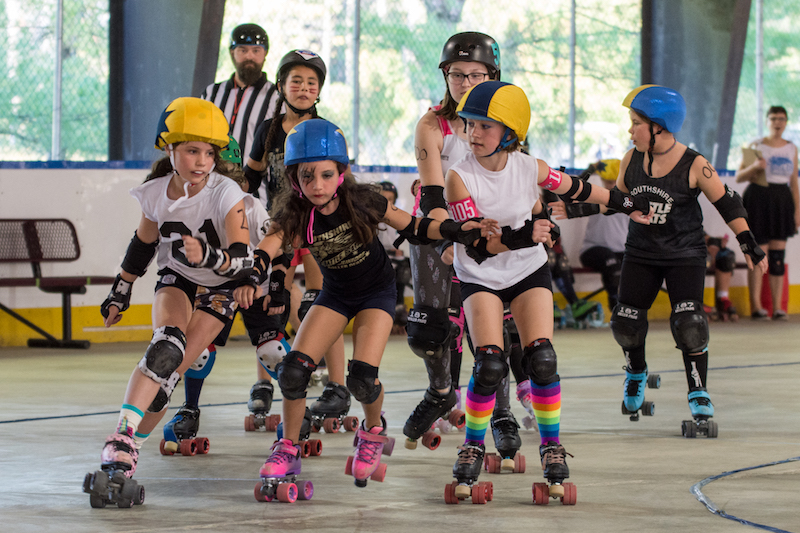
That’s especially true in Southshire’s co-ed junior league, where boys and girls toe the same line at the league’s current practice space, the Gilcrest Skating Rink in Hoosick Falls, N.Y., near Bennington. “It lets girls and boys know that they are physically capable of the same toughness,” says league secretary Sydney Adams, of Schaghticoke, N.Y., who started out as a junior player herself.
In GMRD’s adult league, each rookie skater is also paired with a mentor to answer questions about navigating the rigorous skills assessments required by the sport’s governing body for prospective skaters. “It took me a full year to pass mine,” says DiFonza.
Woodward, one of the two Vermont players who will compete at Worlds this month, was recruited by a former co-worker who saw her skating around Dartmouth’s campus on Rollerblades.
“At every level I’ve played at, I’ve had incredible mentors who, of their own good will, gave me their extra time and patience to help me grow as a skater,” says Woodward of her rapid climb from fresh meat to infamous blocker on the number two-seeded team in the world. “They lit my fire. I wouldn’t be where I am now without them.”
It’s one of the unique qualities that has endured since roller derby’s revival in the early aughts—the idea that as long as the opportunity for mutual empowerment is paid forward from one skater to the next, the sport will grow and thrive powered by volunteerism alone.
Fresh Meat
And so I found myself, this past July, under florescent lights in the Blue Ribbon Pavilion at the Champlain Valley Exposition, trying to stand up on borrowed roller skates for the first time at Green Mountain Roller Derby’s rookie boot camp. I felt like a cartoon character: unwieldy, legs
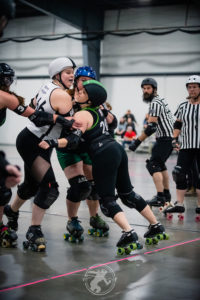
and arms spread wide and uncertain of where I would fall in next. Even with a helmet, mouthguard, kneepads, elbow pads and wrist guards, I was terrified. I was, in derby speak, “Fresh Meat.”
As a veteran skater moved elegantly backwards on her skates, cheerfully beckoning a pack of us newbies forward, we made slow movements, hands out, butts stuck up, uncertain of how to stop. The first drill was learning to fall and then to get back up, again and again.
By the end of the two-hour practice, we joined league skaters for a drill: “27 in Five,” one of several skating skills tests players have to pass before scrimmaging with the team or playing in a WFTDA-sanctioned bout. About 20 skaters took to the track to attempt 27 laps in five minutes.
Despite a summer of trail running, my thighs burned as powerful people with names like Snatch McKraken and Folsom Bruise flew unapologetically within an inch of my unwieldy frame, calling “On your in! On your out!” It was like being in a tunnel, where everyone was competing for the singular, most efficient path around the track. I leaned into my edges, got low, and for a second, felt myself accelerate out of the track’s curve. From the center of the room, through the reverberating noise and cheers, I heard an unfamiliar voice: “Way to take up space, Abagael!”
It was then that I decided I would come back—unwieldy legs be damned.
Featured Photo Caption: Green Mountain Roller Derby skaters like Shelby Armstrong are working to grow their sport in Vermont. Photo courtesy Green Mountain Roller Derby

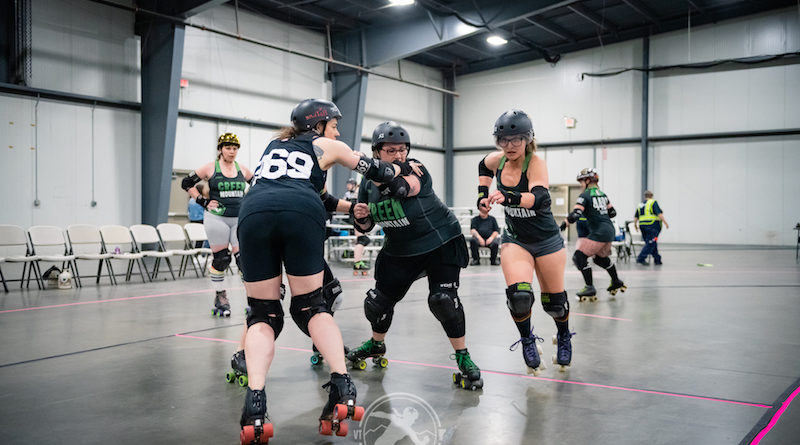
CAPTION CORRECTION!! (3rd Image) – Southshire Battlecats Pivot (helmet stripe) from North Bennington, blocks the Thousand Islands Battle Field Betties jammer (with the star).
Hi Daniel—thank you for your note! We have updated the caption accordingly.